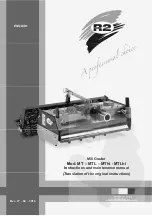
6. Never place hands or feet under implement with tractor engine running or before you
are sure all motion has stopped. Stay clear of all moving parts.
7. Do not reach or place yourself under equipment until it is blocked securely.
8. Do not allow riders on the implement or tractor at any time. There is no safe place
for riders.
9. Before backing up, look behind carefully.
10. Never operate tractor and implement under trees with low hanging limbs. Operators
can be knocked off the tractor and then run over by the implement.
11. The parts of this machine have been designed and tested for rugged use. However,
they could fail upon impact with heavy, solid objects such as steel guard rails and
concrete abutments. Such impact could cause the broken objects to be thrown
outward at very high velocities. To reduce the possibility of property damage, serious
injury, or even death, never allow the machine to contact such obstacles.
12. Frequently check cutting blade. It should be free of nicks and cracks and securely
fastened.
13. Stop implement immediately upon striking an obstruction. Turn engine off, remove
key, inspect and repair any damage before resuming operation.
14. Stay alert for holes, rocks and roots in the terrain and other hidden hazards. Keep
away from drop-offs.
15. Use extreme care and maintain minimum ground speed when transporting on
hillside, over rough ground and when operating close to ditches or fences. Be careful
when turning sharp corners.
16. Before beginning operation, contact local utility companies to make certain there are
no bundled gas lines, electrical cables, etc., in the work area.
17. Reduce speed on slopes and sharp turns to minimize tipping or loss of control. Be
careful when changing directions on slopes. Do not start or stop suddenly on slopes.
Avoid operation on steep slopes.
18. When using a unit, a minimum 20% of tractor and equipment weight must be on
tractor front wheels. Without this weight, tractor could tip over, causing personal
injury or death. The weight may be attained with a front end loader, front wheel
weights, ballast in tires or front tractor weights. When attaining a minimum 20% of
tractor and equipment weight on the front wheels, you must not exceed the ROPS
weight certification. Weigh the tractor and equipment. Do not guess or estimate!
19. Inspect the entire machine periodically
2
. Look for loose fasteners, worn or broken
parts, and leaky or loose fittings.
20. Pass diagonally through sharp dips and avoid sharp drops to prevent “hanging up”
tractor and implement.
21. Avoid sudden starts and stops while traveling up or downhill.
22. Always cut down slopes; never across the face. Avoid operation on steep slopes.
Slow down on sharp turns and slopes to prevent tipping and/or loss of control.
23. Comply with all federal, state and local laws during transport on roads.
24. Before parking the machine, lower the foot stand and secure it with the lock pins.
O
PERATION
10
BEFCO
R
EAR
B
LADES
O
PERATOR
’
S
M
ANUAL
2
See Chapter 4 - Maintenance.











































